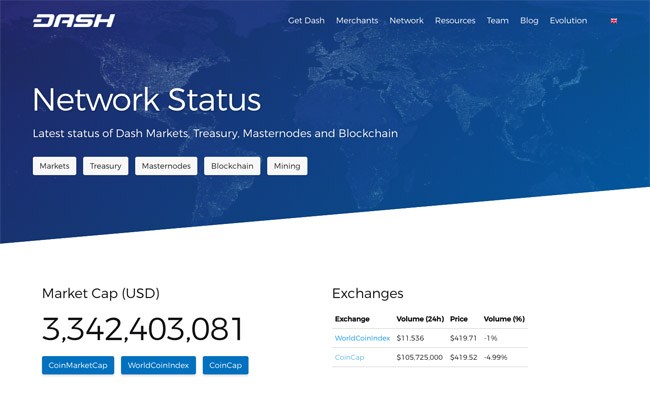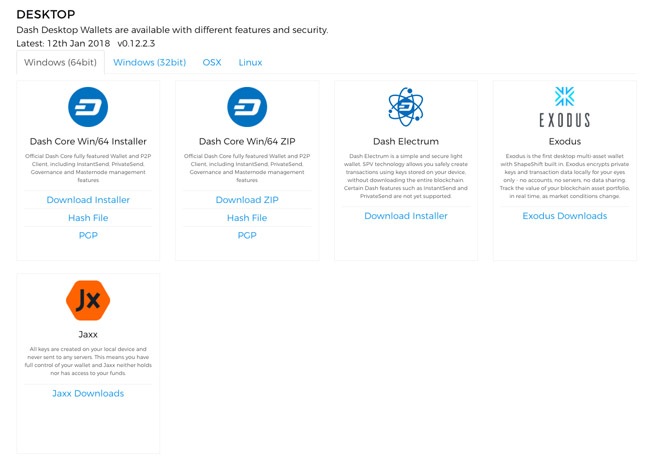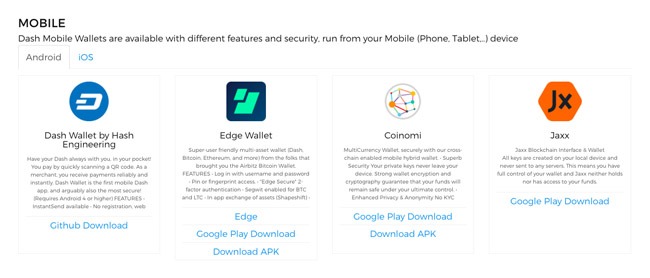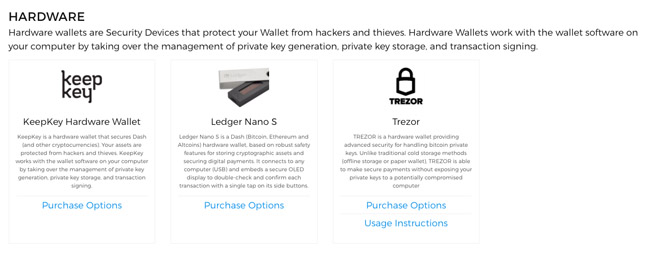The Dash coin was created by Evan Duffield on January 18, 2014. Originally released as XCoin (XCO) and rebranded to Darkcoin in February 2014 – the promising Dash cryptocurrency finally settled on its current name on March 25, 2015.
A derivative of Bitcoin, Dash coin is essentially digital cash that works exactly like physical cash, except it’s exchanged on a highly secure, decentralized peer-to-peer network. It was designed to have a total supply of 18 million coins, 2 million of which were mined during its first day, and around 8 million of which are in circulation at the time of writing.
Because Dash’s code is based on that of Bitcoin, Dash is compatible with all existing wallets and cryptocurrency exchanges originally developed for Bitcoin. When measuring node count by market cap, Dash’s infrastructure robustness is more than an order of magnitude higher than the competitors’ like Bitcoin and Ethereum.
When it comes to Dash’s block reward, it’s worth mentioning that it is distributed among three separate groups: 45% of it go to miners in exchange for the security they provide, 45% go to the so-called MasterNodes (we’ll talk about them in just a minute) for PrivateSend and InstantSend functions, and the remaining 10% constitute Dash’s treasury.
Adding up to about $1 million a year, the funds in the treasury are distributed among developers, marketers, and anyone who is approved for a project.
According to an interview given for CoinGecko.com, Evan first came across Bitcoin in 2010 and, as everyone else entering the cryptocurrency world, didn’t give it any serious thought at first. After reading Satoshi’s white paper, though, he came to realize the “earth-shattering” significance of the technology.
Soon after, Duffield got hooked on Bitcoin and started reading everything he could find about this new and still controversial digital currency. In late 2013 Duffield started following the Let’s Talk Bitcoin podcast created by one of Bitcoin’s most prominent educators Andreas Antonopoulos and kept himself acquainted with the opinions of other leading figures in the up-and-coming community.
However, after following Bitcoins development for quite some time, Duffield was not satisfied with the rate of progress and the direction that Bitcoin was taking.
Truth be told, Bitcoin, in all its glory, still had one major shortcoming: enabling complete anonymity of transactions. Bitcoin’s blockchain is open and transparent and if at any point, by following the path of a transaction, a user is identified to own a certain wallet address, everything that they do on the network from that moment on is traceable back to the very first Genesis block.
This is a mixed issue of fungibility and anonymity, and Duffield found it to be a liability that could lead to privacy invasion, which is the one thing cryptocurrencies were supposed to protect us from.
“I was watching and waiting for the Bitcoin team to do something about the fungibility issue, but it never happened.”- Evan Duffield
And that’s where Dash came into the picture. What started as a weekend project for Duffield ended up getting a lot of attention, so he quit his job and started focusing on it full time. The David to Bitcoin’s Goliath, Dash embodied the idea of instant private transactions relying on distributed ledger technology — and it was just getting started.
Dash’s distinctive features
In order to understand Dash in its entirety, let’s take a closer look at its key characteristics and their underlying mechanisms:
Two-tier network
Much like it is with Bitcoin, Dash’s ecosystem is powered by its nodes. Unlike Bitcoin, however, Dash utilizes not one but two types of nodes. Regular nodes do all the mining that creates new coins on the network, while MasterNodes are in charge of keeping a copy of the blockchain at all times, and of specialized transactions like PrivateSend and InstantSend, which we’ll get into later.
As you can see, there is a difference in the architecture of the two currencies. Bitcoin has a single-tier network, and Dash utilizes a so-called two-tier network; the first layer is comprised of the regular (miner) nodes that secure the network, and the additional second layer is made up of the MasterNodes that are in charge of more complex operations and vital network functionalities. But what makes MasterNodes so special?
MasterNodes
MasterNodes are, essentially, regular nodes that are willing to go the extra mile to ensure the stability and speed of the Dash ecosystem, and to provide its users with advanced technological improvements like PrivateSend and InstantSend.
In order to achieve this, they are given special authority and are incentivized to use their power responsibly by making up for the extra resources they allocate. To become a MasterNode, you are required to:
- Have 1000 DASH coins in your possession as collateral in order to prevent sybil attacks;
- Have a dedicated IP address to host the node;
- Run the node 24 hours/day with no more than 1 hour of connection loss;
It becomes clear that hosting a MasterNode is a huge responsibility that costs actual money and time, which is why MasterNodes are rewarded 45% of the block reward, on every block. Typically, each of them is paid about 2 DASH every 7 days.
They are the decision makers on the network, and the reason they are bestowed with that responsibility is that, owning at least 1000 DASH themselves, they are the most motivated to make good decisions that everyone will profit from. Once its balance drops under 1000 DASH, the MasterNode loses its voting rights on the network and is demoted to a regular node.
Since 2014, the number of MasterNodes has exceeded 4000, which makes Dash’s peer-to-peer network one of the largest in the world.
Privacy and fungibility
Privacy is one essential feature that can make or break a cryptocurrency. It’s not a concept that people take lightly but, surprisingly enough, the term is thrown around very loosely in relation to cryptocurrencies, as most people aren’t usually equipped with the knowledge and patience to do their own research.
Assessing the actual level of privacy that a cryptocurrency offers you requires an advanced understanding of the underlying algorithms and architectures of the currency and its network. While this is a dreadful and painstaking process, it’s important to break through the seemingly bulletproof, perfunctory explanations and see just how much privacy you’re actually granted.
When we talk about Dash, the issue of privacy is inextricably linked with that of fungibility. To say a commodity is fungible is to say that its individual units are essentially interchangeable. With regards to cryptocurrencies, a coin is fungible if its history on the network is impossible to determine, or in other words, if any two coins on the network are indistinguishable from one another. Dash ensures fungibility and, thus, privacy by presenting its users with a feature called PrivateSend.
PrivateSend
Known as DarkSend up until recently, PrivateSend is the utilization of a trustless mixing service provided by the MasterNodes in order to obfuscate the link between the sender and the recipient of a coin. It’s a process that consists of anywhere from 2 to 8 so-called mixing rounds in order to lose the trace of a particular coin. This is how it works:
Let’s say you have 10 DASH you want to transact with, but you don’t want to reveal the amount or the recipient of the transaction to everyone on blockchain (the public ledger containing all transactions.) Although the transactions made on the network aren’t recorded with the user’s first and last name written in the “Sender” field, but rather with a unique address that is in no way linked to the user’s ID, a private or a government agent with sufficient technical knowledge can trace and connect the cryptocurrency owners with their corresponding wallets using all sorts of covert espionage methods.
To mitigate this, Dash puts the transaction through the aforementioned mixing rounds to lose the connection between the sender, the coins, and the receiver.
First off, the 10 DASH you want to send will be broken down into units of 1, 0.1, or even 0.01 DASH. Each of these denominations has its own, newly-created address. After breaking down the transaction input into units, your wallet consults its list of all available MasterNodes, of which there are thousands, and randomly picks one that you haven’t used for mixing recently.
A mixing request which contains the denomination, the number of denominations, and a small fee (that will almost certainly be returned to the wallet once the process is finished) is sent to the chosen MasterNode. In return, the MasterNode creates a so-called session ID that contains the aforementioned information in order to put the mixing request in the “mixing queue”.
Any other users that wish to mix their funds will refer to the mixing queue and, once there are three of you who want to mix the same amount of 10 DASH, the MasterNode initiates the session. Once the MasterNode confirms there are indeed three participants who want to mix their respective 10 DASH, it sends a signal to each of their wallets to start the mixing. As a response, all three wallets supply the node with the following information:
- The transaction input – the address where the 10 DASH are currently stored;
- The transaction output – the address where the 10 DASH are ultimately to be sent;
If this information does, in fact, constitute a valid transaction, the MasterNode then combines it into a ready-to-send transaction. In the next step, this ready-to-send transaction is sent to the participating wallets for verification. The wallets check for two things:
- The numerical value of the input equals that of the output – 10 DASH are to be sent, and 10 DASH are to arrive at the given address, so the MasterNode doesn’t steal any of it for itself;
- The input and output addresses that were originally provided are accurate – the MasterNode didn’t alter the source or the destination of the funds;
If everything’s okay, each wallet signs the transaction with its private key. However, since neither one of the three participants in the mix knows the private keys of the remaining two participants, the signatures that the wallets provide authorize for the transaction to proceed regardless of who the other signers are.
Once this is finalized, the MasterNode broadcasts the transaction to the network in order for it to be processed.
When a transaction undergoes one round of mixing, there’s a 1 in 3 chance that the sender-recipient pair of the transaction written down on the ledger is a match to that of the actual transaction. Those odds decrease to 1 in 9 by the second round, 1 in 27 by the third etc.
There can be up to 8 rounds of mixing before the transaction is finally broadcasted to the ledger, so when someone looks at it, there is absolutely no way of telling who owns the sender’s address (anonymity), or whether the coins that that address sent are indeed its coins (fungibility). PrivateSend is so private, that up until the time of writing of this article, it hasn’t been compromised.
Transaction speed
Although existing cryptocurrencies have opened up the door to secure and decentralized transactions over the Internet, they are still a bit slow for commercial use, as on such decentralized networks all payments are verified through a network-wide consensus.
Dash addressed this issue by introducing implementing an innovative technology called InstantSend (formerly known as InstantX).
InstantSend
Before we go on to explain InstantSend, let’s take a brief look at the life cycle of a cryptocurrency transaction.
Whenever you try to send digital currency from your wallet, that transaction is signed with the wallet’s private key and is broadcasted to the network. But in order to complete the process, it isn’t enough to just broadcast the transaction.
It needs to be confirmed, which means the payment went through and is now irreversible. For a transaction to be confirmed, it needs to be included in the next block of transactions – which means that every block that follows after the transmission of your transaction is actually a confirmation for it.
But who has time for that, right?
As an alternative to regular, slower transacting, Dash introduced InstantSend – an optional feature that allows for transactions to be fully confirmed in as little as four seconds.
InstantSend uses the second layer of the Dash network (comprised of the MasterNodes) to produce a “lock” once a transaction is created, and only moments after you click on the “Send” button to deploy it, the funds are double spend-proof.
When an InstantSend transaction is generated, a quorum of 10 MasterNodes is randomly elected using the Proof-of-Work hash from the preceding block as entropy.
Each of the MasterNodes in the quorum checks their personal copy of the blockchain and then votes on whether or not the funds in question have already been spent:
- If they decide the funds haven’t been spent already, they are “locked” at the recipient’s address for the following hour or so until the Proof-of-Work is finished; the network will reject any subsequent attempt to spend the locked funds again.
- If the consensus is that the funds have already been spent and that there’s is an attempt at double-spending, the transaction is rejected and doesn’t go through.
- If the nodes can’t reach a consensus, the transaction is going to be set aside for validation through standard block confirmation.
Through this quorum system, InstantSend solves the double-spending problem and achieves instant transactions.
As cryptocurrencies approach widespread adoption, Dash has already adapted to be fit for “point of sale” situations where a payment needs to be immediately processed. This isn’t something that should be overlooked as, in theory, vendors who accept Bitcoin could be robbed by their clients.
The client would “pay” for the service, leave, and then spend those funds again. Paying a higher fee the second time around would cause the second payment to be cleared first, and the initial payment (the one made towards the vendor) to fail as a double-spend.
Even though nobody debates the seriousness of the double-spend problem as it is, a point can be made that its implications are even trickier to address in real life situations where things move a lot faster. This is why instant confirmation is essential to cryptocurrencies’ integration in the real world economy.
Dash is a powerful and evolving cryptocurrency. It’s the up-and-coming heir of Bitcoin that aims to bring digital cash closer to the real world.
Keeping the basic principles that brought crypto assets their well-deserved fame, and expanding their use cases using new technologies – Dash is truly on its way to become the first real working version of digital cash.
Getting started with Dash
Now that we’ve looked under the hood, it’s time to learn how to get Dash and how to store it. Suffice to say, we will offer you different options for every step of the way, but it is up to you to use the provided tools responsibly, investigate thoroughly any and all concepts that aren’t as clear to you as they should be, and keep your eyes wide open for any activities that might compromise your identity or your funds.
After all, this is the Internet we’re talking about, and it can’t hurt to be extra cautious especially when there is money involved.
Buy Dash
There are a couple of ways to purchase your first Dash, each having different advantages and disadvantages. Depending on where you are in the world, and whether or not you have existing assets in the form of another cryptocurrency, some options might be better for you than others. Here we will explore five of the most popular ways to buy Dash:
Buy Dash with a credit/debit card or wire transfer
Buying Dash with a credit/debit card or with your bank account can be as easy as opening an account on an exchange of your choosing and depositing your funds to it. Here are some suggestions for exchanges that support direct fiat-to-Dash purchases:
Buy Dash with another cryptocurrency
If the exchange of your choosing doesn’t support direct Dash purchase, you can buy some other supported (transit) currency like Bitcoin or Ethereum first, and then exchange that for Dash using Binance or some other similar service.
If you still haven’t chosen an exchange, however, you should check out Dash’s list of exchanges that support the cryptocurrency. (Note: There is a disclaimer on the bottom of the page, stating that “the list is provided for informational purposes only.”)
Buy Dash with PayPal
If you have a PayPal account, you can use it to buy Dash. Sadly, you’ll have to go through Bitcoin again. There are currently no available options for purchasing Dash directly, but there are numerous guides online to help you get Bitcoin with PayPal.
After that, it’s just a matter of transferring your funds to an exchange (like Binance) and converting them to Dash.
Buy Dash at an ATM
Apparently, the future is here — probably right here in your neighborhood. If you’re lucky enough, you can purchase Dash and other cryptocurrencies for fiat on an ATM close to you! Use CoinATMRadar to find a nearby ATM that allows it, but beware of the slightly higher expenses.
Buy Dash with cash
Finally, there’s always the option to meet up with a local cryptocurrency enthusiast just like yourself and buy Dash from them, on the spot. After all, we didn’t explain InstantSend to you for nothing! Use DashNearby to look for listings made by users in your area and arrange a cash-for-Dash meetup.
Store Dash
In order to receive and store Dash, you need a Dash wallet. While most exchanges offer a local wallet to store your funds in, it’s best that you have full control over your Dash and keep it in a private wallet that is outside of any service you use.
Nowadays you can choose from a myriad of different implementations and versions of wallets, all offering various features. Here are your options:
Web wallet
- MyDashWallet – A web interface to the Dash blockchain, MyDashWallet offers full control of your DASH, instant payment validation, and direct, decentralized access to the peer-to-peer network. It offers advanced Dash features such as InstantSend and PrivateSend while keeping you completely safe by not storing your private keys online.
Desktop wallet
- Dash Core – Dash’s official Windows, OSX, and Linux supported wallet/peer-to-peer client is available for free on their website. Offering InstantSend and PrivateSend, as well as MasterNode management features, Dash Core is the go-to wallet for desktop users.
- Exodus – Available for 64-bit Windows, OSX, and Linux, and endorsed by Dash themselves – Exodus is a multi-asset desktop wallet that has integrated ShapeShift to enable cryptocurrency exchanging.
- The world’s first multi-currency desktop wallet, Exodus enables fluidity in 11 currencies. One drawback is that it doesn’t enable Dash’s PrivateSend and InstantSend features.
- Jaxx – Another wallet recommended by Dash, Jaxx is supported on Windows, OSX, and Linux machines. Jaxx also has ShapeShift built in, but doesn’t feature PrivateSend, or enable InstantSend transactions.
- Dash Electrum – A simple light wallet that doesn’t require a local copy of the blockchain to carry out transactions. Available for 64-bit Windows, OSX, and Linux.
Mobile wallet
- Coinomi – Currently available only for Android devices, Coinomi is a multi-currency mobile wallet for Dash. While it is secure and stable, it doesn’t offer PrivateSend or InstantSend transactions.
- Edge – Edge is another multi-currency wallet featured by Dash on their official website. It is available for iOS and Android. Edge has a ShapeShift integration, and SegWit enabled for Bitcoin and Litecoin transactions too.
- Dash Wallet – A product of Hash engineering, Dash Wallet is the first and most secure mobile wallet for Dash currently available only for Android. It supports InstantSend transactions, but doesn’t utilize the mixing services of the PrivateSend protocol. Dash Wallet allows for offline transactions using Bluetooth.
- Dash Core iOS – The first (and only) Dash wallet designed specifically for iOS, Dash Core iOS connects directly to the Dash network and doesn’t use intermediary servers to carry out transactions, thus securing your funds. It comes with a ShapeShift integration and the InstantSend feature, however it doesn’t have a PrivateSend implementation.
- Jaxx – The popular desktop wallet comes with a mobile version, currently available for iOS and Android.
Hardware wallet
- Ledger Nano S – A hardware wallet that supports Dash as well as Bitcoin, Ethereum, and other altcoins; the Ledger Nano S connects to your computer through a USB port and allows for simple usage through just two buttons and an OLED display. All of your coins are kept offline, and whenever you want to execute a Dash transaction, it is signed using the wallet’s private keys that are stored on the device. PrivateSend and InstantSent aren’t currently supported. You can buy the Ledger Nano S on the official website for €79.
- TREZOR – Currently priced at €89, TREZOR is the world’s first hardware cryptocurrency wallet. It supports 8 different cryptocurrencies, one of which is Dash. It has a small OLED screen and two buttons, and it connects to your computer using a USB cable. TREZOR doesn’t enable for PrivateSend and InstantSend transactions just yet, but supposedly they will be available in the future.
- KeepKey Hardware Wallet – KeepKey is another hardware wallet recommended on Dash’s official website. It supports five other cryptocurrencies and it can be purchased for $129. Slightly larger than the Ledger Nano S and TREZOR, KeepKey still offers a sleek design, with a single button and a port for a USB cable. Obviously, KeepKey keeps your assets and keys secure and protected from malicious actors. PrivateSend and InstantSend are yet to be implemented.
Paper wallet
- Dash Core Paper Waller – A cheaper alternative to hardware wallets, paper wallets are yet another form of cold storage for your cryptoassets. Containing both the private and public address for your DASH, Dash Core Paper Wallet grants full control over the funds to anyone who has access to the piece of paper. While paper wallets aren’t susceptible to hacker attacks like software wallets are, they need to be kept someplace safe in order for them not to get stolen, misused, or lost. Needless to say, paper wallets don’t offer PrivateSend and InstantSend transactions.
Conclusion
While every cryptocurrency has its strengths and weaknesses, Dash seems to be making the best of both worlds. It stands on the shoulders of giants like Bitcoin, learns from peers like Monero, it improves existing solutions, and creates new ones when moving to uncharted territory.
Offering fast, secure and private transactions with very low transaction fees, Dash is a serious rival even to trailblazing cryptocurrencies like Bitcoin and Ethereum. In a highly competitive and ever-changing environment such as the cryptocurrency industry, only the strongest survive.
Whether we’ll be seeing Dash’s adoption by the vast majority of crypto users and merchants depends on many unenumerable and uncontrollable factors. Dash’s vision to create a revolutionary digital money system seems to be working very well thus far.
Will it continue to grow or will it face the same faith as the thousands of failed cryptocurrencies flooding the market? What do you think? Where do you see Dash in the next 5 to 10 years?
Tell us what you think in the comment section below.




